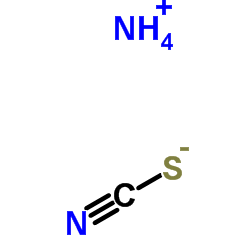Ammonium thiocyanate

Ammonium thiocyanate structure
|
Common Name | Ammonium thiocyanate | ||
|---|---|---|---|---|
| CAS Number | 1762-95-4 | Molecular Weight | 76.121 | |
| Density | 1.3 | Boiling Point | 146ºC at 760 mmHg | |
| Molecular Formula | CH4N2S | Melting Point | 152-154 °C(lit.) | |
| MSDS | Chinese USA | Flash Point | 190 °C | |
| Symbol |

GHS07 |
Signal Word | Warning | |
|
Development of ultrasound-assisted emulsification microextraction for determination of thiocynate ion in human urine and saliva samples.
J. Chromatogr. B. Analyt. Technol. Biomed. Life Sci. 917-918 , 5-10, (2013) Ultrasound-assisted emulsification microextraction (USAE-ME) procedure coupled with UV-vis spectrophotometric measurement has been developed for determination of thiocyanate ion (SCN(-)) in water and biological fluids samples. The method is based on protonati... |
|
|
In vitro investigations on the effect of dermal fibroblasts on keratinocyte responses to ultraviolet B radiation.
Photochem. Photobiol. 90(6) , 1332-9, (2014) Exposure to ultraviolet radiation is closely linked to the development of skin cancers in humans. The ultraviolet B (UVB) radiation wavelength (280-320 nm), in particular, causes DNA damage in epidermal keratinocytes, which are linked to the generation of sig... |
|
|
Oral administration of paeoniflorin attenuates allergic contact dermatitis by inhibiting dendritic cell migration and Th1 and Th17 differentiation in a mouse model.
Int. Immunopharmacol. 25(2) , 432-9, (2015) Allergic contact dermatitis (ACD) is a hapten-specific CD4(+) T-cells mediated inflammatory response of the skin. Its pathomechanism involves 2 phases, an induction phase and an elicitation phase. Langerhans cells (LCs) and dendritic cells (DCs) in the skin p... |
|
|
Mechanisms of chemical cooperative carcinogenesis by epidermal Langerhans cells.
J. Invest. Dermatol. 135(5) , 1405-14, (2015) Cutaneous squamous cell carcinoma (SCC) is the most prevalent invasive malignancy with metastatic potential. The epidermis is exposed to a variety of environmental DNA-damaging chemicals, principal among which are polyaromatic hydrocarbons (PAHs) ubiquitous i... |
|
|
Effect of lyophilization on liposomal encapsulation of salmon calcitonin.
J. Liposome Res. 24(4) , 297-303, (2014) The intent of this work was to assess the impact of lyophilization on the encapsulation of salmon calcitonin (sCT) into liposomes.Four different liposomal formulations were investigated, i.e. DPPC:Chol:DSPE-PEG(2000) (75:20:5 and 65:30:5) and DPPC:Chol (80:20... |
|
|
Microencapsulation of (deoxythymidine)₂₀-DOTAP complexes in stealth liposomes optimized by Taguchi design.
J. Liposome Res. 25(1) , 67-77, (2015) Stealth liposomes encapsulating oligonucleotides are considered as promising non-viral gene delivery carriers; however, general preparation procedures are not capable to encapsulate nucleic acids (NAs) efficiently. In this study, the lyophobic complexes of de... |
|
|
Kafirin Nanoparticle-Stabilized Pickering Emulsions as Oral Delivery Vehicles: Physicochemical Stability and in Vitro Digestion Profile.
J. Agric. Food Chem. 63 , 10263-70, (2015) Kafirin nanoparticle-stabilized Pickering emulsions (KPEs) were used to encapsulate curcumin. The stability of KPEs under processing conditions and their protective effects against photo-oxidation of curcumin and lipid oxidation of oil in emulsions, as well a... |
|
|
Skin response to a carcinogen involves the xenobiotic receptor pregnane X receptor.
Exp. Dermatol. 24 , 835-40, (2016) Skin is in daily contact with potentially harmful molecules from the environment such as cigarette smoke, automobile emissions, industrial soot and groundwater. Pregnane X receptor (PXR) is a transcription factor expressed in liver and intestine that is activ... |
|
|
In vitro anti-aging activities of extracts from leaves of Ma Kiang (Cleistocalyx nervosum var. paniala).
Pharm. Biol. 53(6) , 862-9, (2015) Cleistocalyx nervosum (DC.) Kosterm. var. paniala (Roxb.) J. Parn. & Chantaran. (Myrtaceae) or Ma Kiang contains high amounts of phenolic compounds. Antioxidant activity of its fruit and seed has been investigated. However, limited available information conce... |
|
|
Synthesis of Amphiphilic Ru(II) Heteroleptic Complexes Based on Benzo[1,2-b:4,5-b']dithiophene: Relevance of the Half-Sandwich Complex Intermediate and Solvent Compatibility.
Chemistry 21 , 16252-65, (2015) The detailed synthesis and characterization of four ruthenium(II) complexes [RuLL'(NCS)2 ] is reported, in which L represents a 2,2'-bipyridine ligand functionalized at the 4,4' positions with benzo[1,2-b:4,5-b']dithiophene derivatives (BDT) and L' is 2,2'-bi... |